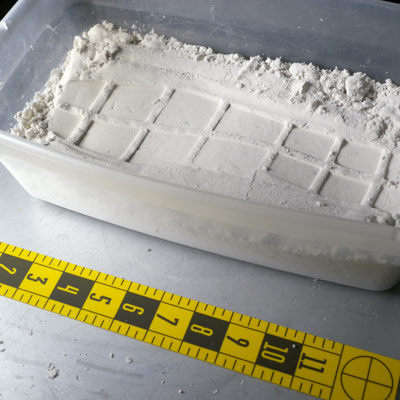

We interpret our results by considering any points of similarity or points of difference noted in step three to come to our conclusion. This involves comparing the prints and the marks by eye, noting any similarities or points of difference. We would then overlay our test marks onto the crime scene marks to conduct our comparison. Test prints are a representation of the sole of the footwear and the mark that the sole would leave as it makes contact with a surface. We will then examine the footwear items and create test prints. Examination of footwear items – test prints.

We prefer marks to be submitted as original items as it gives us scope to use these techniques at the laboratory under ideal conditions to garner the best results. The first thing we do at the laboratory is enhance the scene marks that are submitted to us and put them in a format that is suitable for comparison, for example using photography or gel lifting. Typically, this is a six-stage process that involves the following steps: How is a footwear mark examination carried out at Forensic Access? This would ensure that there is a permanent record of the mark prior to lifting, because there may be features visible in the photograph which are not clear in the lifted mark. This could involve photography first, for example, followed by gelatin lifting. Police protocol may dictate that the Crime Scene Examiner (CSE) should utilise several of the methods outlined above in a specific sequence. Marks can also be recorded using photography, whilst 3D marks, such as marks in mud, can be recovered via casting. Electrostatic lifts involve placing a film over a given mark which is then subjected to an electric charge. Electrostatic lifting is often an effective method of recovering dusty marks. Gelatin lifts are typically effective at lifting dirty marks. Gelatin lifting uses a lift made of gelatin on a plastic backing which is then placed over the mark to lift it. For items larger than that, the police need to recover the footwear marks from the scene for submission to the laboratory.įootwear marks can be recovered from the scene via lifting. Here at Forensic Access, we always ask that the original item is submitted if possible – it could be a piece of paper from the floor, something slightly larger like a wing mirror from a car if it’s been kicked in a criminal damage case, or even a chair. One of the first things that police need to do to do when dealing with a crime scene is to recover any footwear marks that are present and submit them to the laboratory. During the analysis a shoe is compared against a footwear mark in terms of pattern, pattern arrangement and wear and fine detail, including characteristic damage. It is one of the few evidence types that can provide a conclusive link.
#Shoe impression evidence interview series#
Forensic Access’ webinar series for 2022 kicks off with Dr Sarah Jacob presenting “Footwear Mark Evidence: How we use trace evidence to help your case” and we have created a Footwear Mark Evidence 101 to get you up to speed with this crucial area of forensic chemistry.įootwear Mark Evidence is the comparison of physical characteristics between footwear items (i.e., a shoe) and marks recovered from a crime scene such as burglary.


 0 kommentar(er)
0 kommentar(er)
